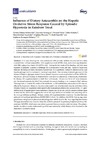Please use this identifier to cite or link to this item:
https://accedacris.ulpgc.es/jspui/handle/10553/59991
| Title: | Influence of dietary astaxanthin on the hepatic oxidative stress response caused by episodic hyperoxia in rainbow trout | Authors: | Kalinowski, Carmen Tatiana Larroquet, Laurence Véron, Vincent Robaina, Lidia Izquierdo, María Soledad Panserat, Stéphane Kaushik, Sachi Fontagné-Dicharry, Stéphanie |
UNESCO Clasification: | 310502 Piscicultura 3109 Ciencias veterinarias |
Keywords: | Astaxanthin Episodic hyperoxia Liver Oxidative status Rainbow trout |
Issue Date: | 2019 | Journal: | Antioxidants | Abstract: | A 13-week feeding trial was carried out with juvenile rainbow trout to test two diets: a control diet without astaxanthin (AX) supplementation (CTRL diet), and a diet supplemented with 100 mg/kg of synthetic AX (ASTA diet). During the last week of the feeding trial, fish were exposed to episodic hyperoxia challenge for 8 consecutive hours per day. Episodic hyperoxia induced physiological stress responses characterized by a significant increase in plasma cortisol and hepatic glycogen and a decrease in plasma glucose levels. The decrease of plasma glucose and the increase of hepatic glycogen content due to episodic hyperoxia were emphasized with the ASTA diet. Hyperoxia led to an increase in thiobarbituric acid-reactive substances in the muscle, diminished by dietary AX supplementation in both liver and muscle. Muscle and liver AX were increased and decreased respectively after 7-day episodic hyperoxia, leading to an increase in flesh redness. This augment of muscle AX could not be attributed to AX mobilization, since plasma AX was not affected by hyperoxia. Moreover, hyperoxia decreased most of antioxidant enzyme activities in liver, whereas dietary AX supplementation specifically increased glutathione reductase activity. A higher mRNA level of hepatic glutathione reductase, thioredoxin reductase, and glutamate-cysteine ligase in trout fed the ASTA diet suggests the role of AX in glutathione and thioredoxin recycling and in de novo glutathione synthesis. Indeed, dietary AX supplementation improved the ratio between reduced and oxidized glutathione (GSH/GSSG) in liver. In addition, the ASTA diet up-regulated glucokinase and glucose-6-phosphate dehydrogenase mRNA level in the liver, signaling that dietary AX supplementation may also stimulate the oxidative phase of the pentose phosphate pathway that produces NADPH, which provides reducing power that counteracts oxidative stress. The present results provide a broader understanding of the mechanisms by which dietary AX is involved in the reduction of oxidative status. | URI: | https://accedacris.ulpgc.es/handle/10553/59991 | ISSN: | 2076-3921 | DOI: | 10.3390/antiox8120626 | Source: | Antioxidants [ISSN 2076-3921], v. 8 (12), 626 |
| Appears in Collections: | Artículos |
SCOPUSTM
Citations
24
checked on Jun 8, 2025
WEB OF SCIENCETM
Citations
21
checked on Jun 8, 2025
Page view(s)
145
checked on Nov 2, 2024
Download(s)
119
checked on Nov 2, 2024
Google ScholarTM
Check
Altmetric
Share
Export metadata
Items in accedaCRIS are protected by copyright, with all rights reserved, unless otherwise indicated.
